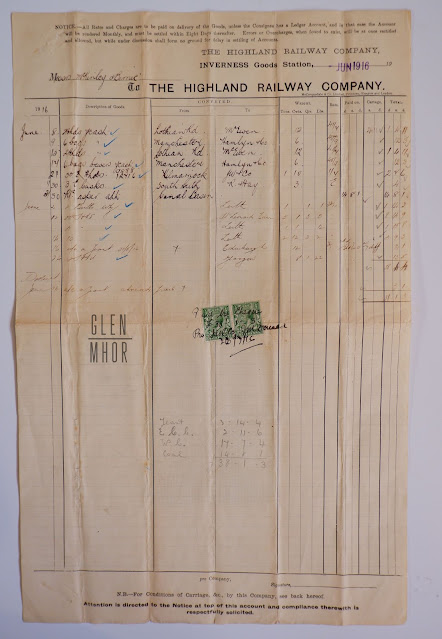June 1916 The Highland Railway Company
I'm pleased to resume my research on the topic of train invoices for Glen Mhor and, in particular, the Highland Railway Company. This is a subject I have previously explored, in 2021, with a series of invoices dating from 1917 that provided a fascinating insight into the activities at the distillery.
I remain grateful to the wider community for their assistance in acquiring a collection of Glen Mhor-related documents in late 2023. This has enabled me to examine a clutch of additional train invoices, seven in total, from the preceding year. We're kicking off the process now with June 1916 first up.
It is worth noting that the invoice in question, which should be Mackinlay, refers to Messrs McKinley & Birnie. As this is prior to 1921, it relates to the transportation of goods to the Glen Mhor distillery only, so we have total confidence in what it is giving us.
The transcription of the entries (omitting weight and costings) is as below. I have retained the original order of the entries, rather than the date order, as it appears that this invoice was amended by another official to include six further entries for June.
'June 8th, Hogheads yeast (conveyed) Lothian Road, McEwen.
June 9th, 6 bags yeast (conveyed) Manchester, Hamlyn & Co.
June 15th, 2 hogsheads yeast (conveyed) Lothian Road, McEwen.
June 17th, 6 bags brewers yeast (conveyed) Manchester, Hamlyn & Co.
June 21st, 30 hogsheads 9888 12716, (conveyed) Kilmarnock, JW & Co.
June 30th, 3 casks, (conveyed) South Leith, R.Kay (likely to be Rutherford & Kay).
June 30th, r/c asper? ???, Canal basin.
June 2nd, 2 butts dry?, (conveyed) Leith.
June 12th, 20 hogsheads (conveyed) St. Leonards Edinburgh.
June 12th, 8 hogsheads (conveyed) Leith.
June 14th, 10 hogsheads (conveyed) Leith.
June 16th, r/c on yeast 31/5/16 (conveyed) Edinburgh.
June 24th, 20? hogheads (conveyed) Glasgow.
Deduct. June 16 a/c on yeast already paid.'
A review of the existing 1917 invoices reveals a consistency in yeast suppliers and regular shipments. This is to be expected, given the findings of a prior yeast-related article and the documented shipments the following year. Additionally, a significant number of the same destinations for casks were identified, with Walker & Sons (JW & Co.) being the primary recipient.
The reverse provides the standard terms and conditions, with the usual Glen Mhor office filing system comments.
Of interest is the mention of the canal basin as an entry, which will be at Muirtown and opposite the Glen Albyn distillery. It is unclear what this is referring to, but it is notable that the sums at the bottom of the page include an entry for 'coal', which is not listed above.
If this relates to coal, as it is unlikely that a small shipment would utilise the canal basin. It is regrettable that the entry does not provide a weight, and that the movement of goods from the basin to or from the distillery would have been a brief trip. However, the fee of £14-8-1 is considerable in comparison to the other three categories, indicating that the goods were of sufficient weight to be transported by boat and landed nearby. The only contenders for this would be barley, coal, or a sizeable item related to distillation. There is no mention of barley on the invoice, or a non-coal item of weight.
Alan Winchester also picked up on the coal aspect, with his thoughts being:
'Very interesting, you can see they have been spreading the net for yeast, and Hamyln's being used. As we expected these casks were returned to Brewery of origin.
I think the Dava peats were delivered to Canal basin, shorter haulage to distillery. Interesting to see different filling customers.'
Interestingly, we know that in February 1917, coal was being moved by cart to the distillery, possibly via the other port at Inverness that allowed much larger loads to be landed.
If the substance in question is coal, then it is possible that the distillery utilised Bowhill in Fife, which was known to be a source of this material. It is also possible that the substance is coal from another field in the Kingdom, as this was the most common source of good-quality coal in Scotland, produced in large quantities. Fife alone had over fifty collieries producing this resource, and it is possible that a later invoice in this trove of documents may provide further insight.


Comments
Post a Comment